Air of Authority - A History of RAF Organisation
No 500 - 520 Squadron Histories
Numbers in the 500 series were originally allocated to squadrons of the Special Reserve but only five such squadrons had been formed before they were absorbed into the Auxiliary Air Force. As more squadrons were required by the wartime expansion of the RAF, numbers in this series began to be formed as the 300 and 400 series were allocated to Foreign and Commonwealth units.
No 500 (County of Kent) Squadron
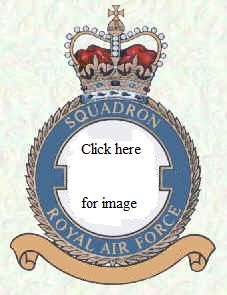 Formed as a Special Reserve squadron at Manston on 16 March 1931, it was
composed of a mixture of regular and reserve personnel and was allocated to the
night bomber role equipped with Virginias. However, the squadron was
re-designated a day bomber squadron in December 1935, for which it received
Harts.
Formed as a Special Reserve squadron at Manston on 16 March 1931, it was
composed of a mixture of regular and reserve personnel and was allocated to the
night bomber role equipped with Virginias. However, the squadron was
re-designated a day bomber squadron in December 1935, for which it received
Harts.
On 25 May 1936 the squadron was transferred to the Auxiliary Air Force and in February 1937, Hinds replaced the Harts, but on 7 November 1938 the squadron was allocated the new role of General Reconnaissance and was transferred to coastal Command.
.Equipped with Anson its carried out coastal patrols over the Channel and the North Sea. Blenheims arrived in April 1941, when the squadron took on a more offensive role against coastal targets. Re-equipped with Hudsons, it flew patrols over the Atlantic and Clyde from Scotland and then moved south again to operate from Cornwall.
Following the Allied
invasion of North Africa, the squadron moved to Gibraltar and later operated
from North African bases. In September 1943 a
detachment moved into Ghisonaccia on Corsica, following the German withdrawal,
remaining until January/February 1944. Venturas began to replace Hudsons in December
1943 but on 11 July 1944, its aircraft were handed over to No 27 Squadron SAAF
and the squadron disbanded.
However, many of its personnel were reformed into a new No 500 at La Senia, where it had disbanded, on 1 August 1944. It was now equipped with Baltimores which it used on daylight bombing missions before changing to night interdiction operations until the end of the war. In September 1945 the squadron was posted to Kenya, but on arrival it was disbanded by being re-numbered No 249 Squadron.
With the reactivation of the Royal Auxiliary Air Force, 500 was reformed on 10 May 1946 at West Malling as a night fighter squadron, its initial equipment of Mosquito NF 30s arriving in October. In July 1948 the squadron converted to Meteor F 3s in the day fighter role. Meteor F 4s were received in Jul 1951 and F 8s in November but along with all the flying units of the RAuxAF, it was disbanded on 10 March 1957.
| Standards | Battle Honours* |
| Standard
originally awarded on 15 Oct 1957 but presented:-
? |
Channel and North Sea, 1939-41: Dunkirk: Biscay Ports, 1941: Atlantic, 1941-42: North Africa, 1942-43: Mediterranean, 1942-44: Italy, 1944-45: |
Squadron Codes used: -
| SQ | Apr 1939 - Sep 1939 |
| MK | Sep 1939 - Nov 1942 |
| RAA | May 1946 - 1950 |
| S7 | 1950 - 1951 |
[Aircraft & Markings | Personnel, aircraft and locations | Commanding Officers]
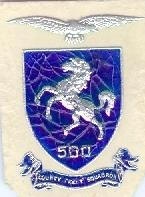 |
| Original Squadron badge |
No 501 (City of Bristol) Squadron
No 501 (County of Gloucester) Squadron
 Formed as a Special Reserve squadron at Filton on 14 June 1929, it was
composed of a mixture of regular and reserve personnel, initially operating
under the name 'City of Bristol' but this was changed to 'County of Gloucester'
on 1 May 1930. Operating in the day bomber role it was initially equipped with
DH9As, replacing these with Wapitis in 1930 and Wallaces in 1933. On 1 May
1936 the squadron was transferred to the Auxiliary Air Force and in July it
received Harts, these in turn being replaced by Hinds in March 1938.
Formed as a Special Reserve squadron at Filton on 14 June 1929, it was
composed of a mixture of regular and reserve personnel, initially operating
under the name 'City of Bristol' but this was changed to 'County of Gloucester'
on 1 May 1930. Operating in the day bomber role it was initially equipped with
DH9As, replacing these with Wapitis in 1930 and Wallaces in 1933. On 1 May
1936 the squadron was transferred to the Auxiliary Air Force and in July it
received Harts, these in turn being replaced by Hinds in March 1938.
In December 1938, the squadron began converting to the fighter role, receiving its first Hurricanes in March 1939. It provided fighter cover for the AASF in France from May 1940, where it acquired an enviable reputation. It served throughout the Battle of Britain and in early 1941 began offensive sweeps over the continent. Converting to Spitfires in April 1941, the squadron moved to Northern Ireland in October 1942.
Returning to the south of England in April 1943, it converted to Tempests just in time to take part in operations again V1 flying bombs. It remained based in the south of England for the remainder of the war disbanding at Hunsdon on 20 April 1945.
With the reactivation of the Royal Auxiliary Air Force, 501 was reformed on 10 May 1946 at Filton as a day fighter squadron, its initial equipment of Spitfire LF 16s arriving in November. Vampires began to arrive in November 1948 with the last Spitfires having left by January 1949. FB 5s replaced F 1s from March 1951 and it operated these until, along with all the flying units of the RAuxAF, it was disbanded on 10 March 1957. Some FB 9s were received in February 1955 but these had been retired before disbandment. It was re-formed as a RAuxAF in the Operations Support role at Brize Norton in 2001 absorbing No 2624 Squadron RAuxAF Regiment.
| Standards | Battle Honours* |
| Standard
originally awarded on 4 Dec 1956 but presented:-
? |
France & Low Countries, 1940: Battle of Britain, 1940: Home Defence, 1940-45: Fortress Europe, 1940-44: Channel & North Sea, 1940-44: France & Germany, 1944: Normandy, 1944: |
Squadron Codes used: -
| ZH | Apr 1939 - Sep 1939 |
| SD | Sep 1939 -Apr 1945, 1949 - 1951 |
| RAB | May 1946 - 1949 |
 |
| Wallaces of No 501 Squadron flying over the
Clifton Suspension Bridge Photo courtesy of Kevin Earl (whose grandparents lived in the house marked 'X' |
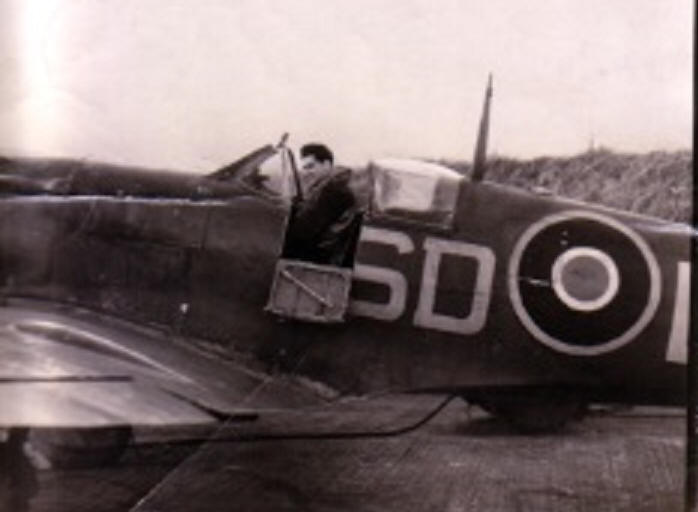 |
| Spitfire of No 501 Squadron at Kenley |
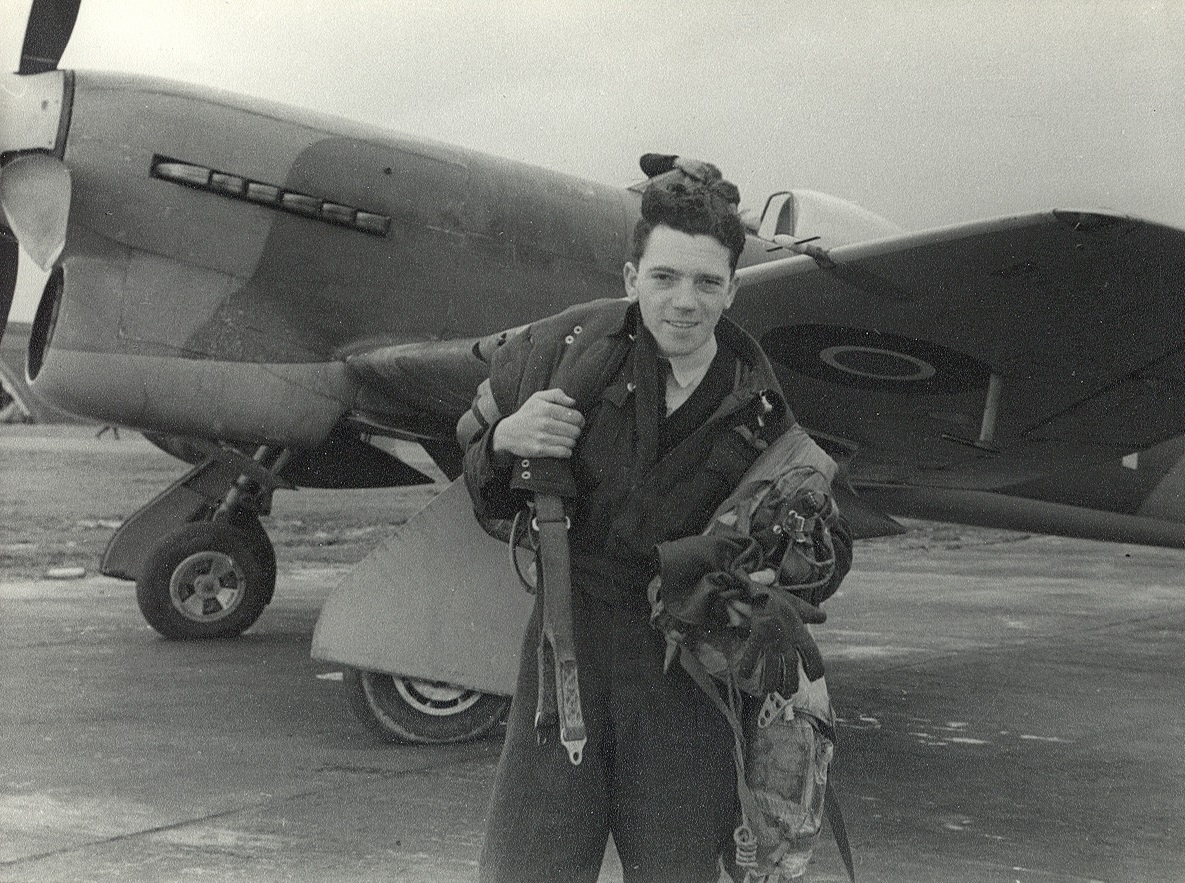 |
| Gilbert Wild whilst serving with No 501 Squadron - 1944 |
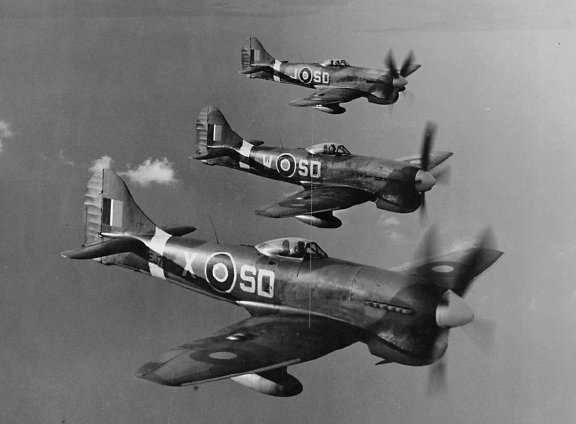 |
| Gilbert Wild flying 'X' of No 501 Squadron - 1944 |
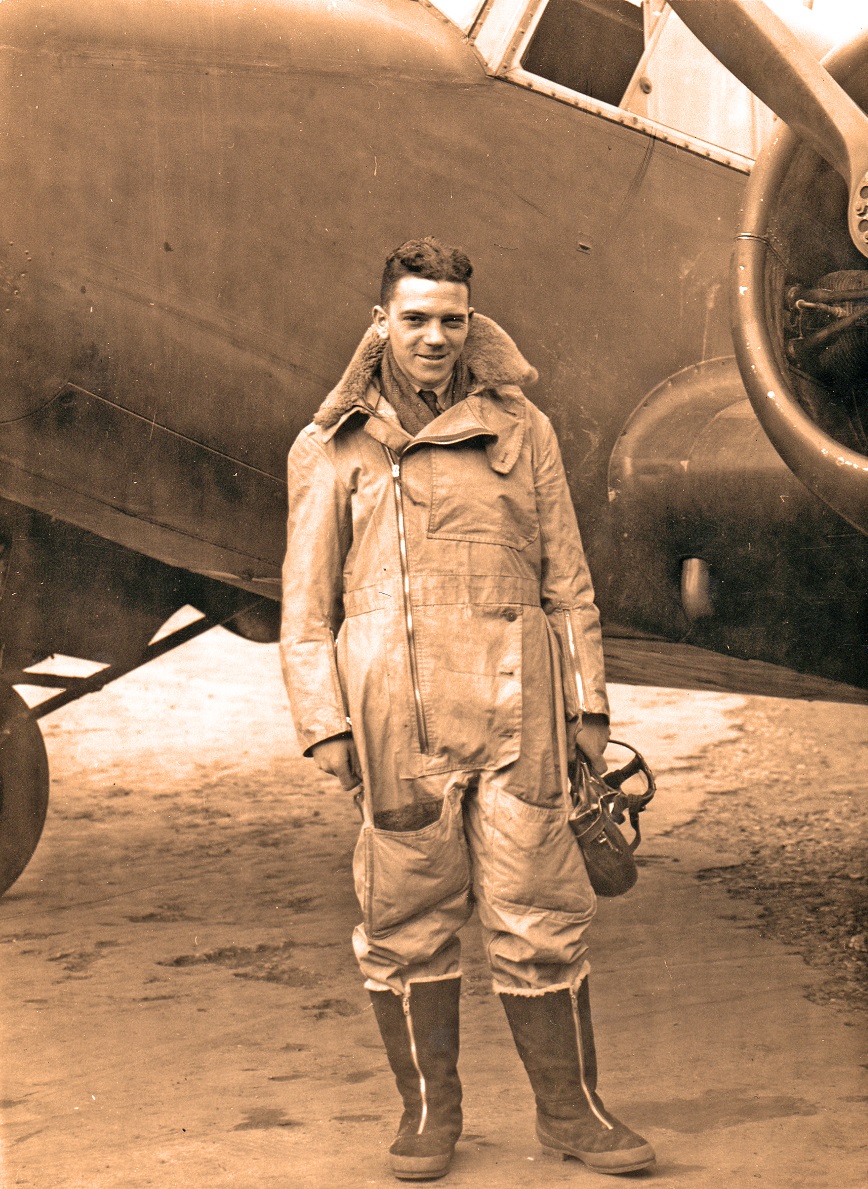 |
| Gilbert Wild in training Photos courtesy of Peter Wild, whose father, Gilbert was a member of the unit at this time) |
[Aircraft & Markings | Personnel, aircraft and locations | Commanding Officers]
 Formed as a Special Reserve squadron at Aldergrove on 15 May 1925, it was
composed of a mixture of regular and reserve personnel. Operating in the
heavy bomber role it was initially equipped with Vimys from June, re-equipping
with Hyderabads in July 1928. Virginias arrived in December 1931, but in
October 1935 the squadron was transferred to the day bomber role for which it
received Wallaces, Hinds arriving in April 1937. Shortly after this in
July, it was transferred to the AuxAF, the Special Reserve being disbanded.
Formed as a Special Reserve squadron at Aldergrove on 15 May 1925, it was
composed of a mixture of regular and reserve personnel. Operating in the
heavy bomber role it was initially equipped with Vimys from June, re-equipping
with Hyderabads in July 1928. Virginias arrived in December 1931, but in
October 1935 the squadron was transferred to the day bomber role for which it
received Wallaces, Hinds arriving in April 1937. Shortly after this in
July, it was transferred to the AuxAF, the Special Reserve being disbanded.
A further change of role occurred on 28 November 1938 when it was transferred to Coastal Command control, initially still equipped with Hinds. Ansons arrived in January 1939, which it flew on coastal patrols around the Ulster coast and over the Irish Sea. Whitleys replaced the Ansons in October 1940 and in January 1942, the squadron moved to East Anglia, where it set up a maintenance facility, whilst carrying out operations from St Eval.
During its time in Ulster, the squadron had carried some of the earliest trials with ASV radar and on 30 November 1941 had made the Coastal Command's first successful attack on a submarine, sinking the U-206. Halifax IIs replaced the Whitleys in January 1943, March saw it moving to Holmsley South and d in December to St David's. The squadron moved once again, this time to Scotland in September 1944, where it was based at Stornoway allowing it to carry out attacks against enemy shipping off the Norwegian coast. It disbanded there on 25 May 1945.
With the reactivation of the Royal Auxiliary Air Force, 502 was reformed on 10 May 1946 at Aldergrove as a light bomber squadron, equipped with Mosquito B 25s from July. In December night fighter Mosquitoes replaced the bombers but in June 1948, it converted to the day fighter role, receiving Spitfire F 22s for the purpose. Jet conversion began in January 1951 with the arrival of Vampire FB 5s, which were supplemented by FB 9s in July 1954. It continued to fly both types until, along with all the flying units of the RAuxAF, it was disbanded on 10 March 1957. The squadron reformed in 2013 at Aldergrove Air Station as a multi-role unit.
| Standards | Battle Honours* |
| Standard
originally awarded on 15 Jan 1952 but presented:-
24 May 1954 Governor of Northern Ireland, Lord Wakerhurst |
Atlantic, 1939-44: Biscay, 1941-44: Channel & North Sea, 1942-45: Dieppe: Baltic, 1944-45: |
Squadron Codes used: -
| KQ | Apr 1939 - Sep 1939 |
| YG | Sep 1939 - Feb 1943 |
| V9 | Jun 1944 - May 1945, 1949 - 1953 |
| RAC | May 1946 - 1949 |
[Aircraft & Markings | Personnel, aircraft and locations | Commanding Officers]
No 503 (City of Lincoln) Squadron
Formed as a Special Reserve squadron at Waddington on 5 October 1926, it was composed of a mixture of regular and reserve personnel. Operating in the day bomber role it was equipped with Fawns, but with the arrival of Hyderabads in 1929 it converted to the night bomber role. Hinaidis were received in 1933 but it reverted to the day bomber role in October 1935, receiving Wallaces for this purpose.
On 18 May 1936, all the Special Reserve squadrons were transferred to the Auxiliary Air Force and in June 1936, Harts replaced the Wallaces these in turn being replaced by Hinds in 1938. However, the squadron never fully re-equipped as it was disbanded on 1 November 1938, it's personnel being used to form the nucleus of No 616 (South Yorkshire) Squadron AuxAF at Doncaster.
No Badge Authorised
Squadron Codes used: -
| VJ | Allocated Apr 1939 - Sep 1939 |
[Aircraft & Markings | Personnel, aircraft and locations | Commanding Officers]
No 504 (County of Nottingham) Squadron
 Formed as a Special Reserve squadron at Hucknell on 26 March 1928, it was
composed of a mixture of regular and reserve personnel. Operating in the
day bomber role it was equipped with Horsleys, Wallaces from February 1935 and
Hinds from May 1937. However, on 18 May 1936, all the Special Reserve
squadrons were transferred to the Auxiliary Air Force.
Formed as a Special Reserve squadron at Hucknell on 26 March 1928, it was
composed of a mixture of regular and reserve personnel. Operating in the
day bomber role it was equipped with Horsleys, Wallaces from February 1935 and
Hinds from May 1937. However, on 18 May 1936, all the Special Reserve
squadrons were transferred to the Auxiliary Air Force.
As with most AuxAF units it was re-designated as a fighter squadron on 31 October 1938, but it was March 1939 before Hurricanes were received. Until May 1940 it operated from Digby and Debden when it was temporarily detached to France but was soon back in the UK. From June 1940 it operated in Scotland defending Scapa Flow, moving to join in the Battle of Britain in September.
Offensive sweeps over the continent were flown until the squadron moved to Northern Ireland in August 1941. Back to England a year later was followed by yet another move to Scotland in September 1943. It moved south again in time to take part in operations connected with Overlord, remaining on these duties until March 1945 when the squadron converted to Meteors at Colerne. However, its life as a jet fighter unit was short-lived as it was re-numbered No 245 Squadron on 10 August 1945.
With the reactivation of the Royal Auxiliary Air Force, 504 was reformed on 10 May 1946 at Syerston as a light bomber squadron. It was initially equipped with training aircraft but in April 1947, it was re-designated a night fighter unit receiving Mosquito T 3s and NF 30s. It role was changed once again in May 1948 to that of day fighter unit, for which it received Spitfire F 22s flying these until October 1948 when Meteor F 4s replaced them. These were replaced by F 8s in March 1952 but along with all the flying units of the RAuxAF, it was disbanded on 10 March 1957.
With the decision to re-activate the RAuxAF flying squadron numbers it was reformed from The Offensive Support Role Squadron at RAF Cottesmore on 1 October 1999. Its primary role is Force Protection, as well as providing a range of passive duties, including Nuclear, Biological and Chemical warning and reporting, and acting as guards and sentries. With the closure of RAF Cottesmore, it moved to Wittering on 31 March 2012 where its role was changed from First Line Support to Logistic Support on 1 April 2013.
| Standards | Battle Honours* |
|
France & Low Countries, 1940: Battle of Britain, 1940: Home Defence, 1940-42: Atlantic, 1941-42: Fortress Europe, 1942- 44: Normandy, 1944: Arnhem: France & Germany, 1944-45: |
Squadron Codes used: -
| AW | Apr 1939 - Sep 1939 |
| TM | Sep 1939 - 1Aug 1945, 1949 - 1952 |
| RAD | May 1946 - 1949 |
e-book by Susan Steel about her late Father's, George Bett, memories of his experiences in WW2 serving as an armourer
[Aircraft & Markings | Personnel, aircraft and locations | Commanding Officers]
The following squadrons were never formed but codes were allocated to them for the period April 1939 to September 1939: -
| No 505 Squadron | YF |
| No 506 Squadron | FS |
| No 507 Squadron | GX |
| No 508 Squadron | DY |
| No 509 Squadron | BQ |
Formed at Hendon on 15 October , the squadron took over the varied array of light aircraft previously operated by No 24 Squadron, when that unit converted to the pure transport role.
Using this fleet of aircraft it carried out communications duties throughout the UK until being disbanded on 8 April 1944, by being re-named the Metropolitan Communications Squadron.
No Badge Authorised
Squadron Codes used: -
| - | Codes, if any, not known |
[Aircraft & Markings | Commanding Officers]
 Formed
at Lyneham from No 1425 Flight on 10 October 1942, it continued to utilise its
Liberators on route flying from the UK to Gibraltar, a detachment at Gibraltar
maintaining a further link to Malta, using Albemarles. From July 1944 the squadron began to concentrate on long distance
routes, employing Yorks in 'A' Flight and Liberators in 'B' Flight.
When the Liberators were transferred to No 246 Squadron in December 1944,
the squadron became solely York equipped. It continued trooping
flights to the Middle East and the Far East until disbanding on 7
October 1946.
Formed
at Lyneham from No 1425 Flight on 10 October 1942, it continued to utilise its
Liberators on route flying from the UK to Gibraltar, a detachment at Gibraltar
maintaining a further link to Malta, using Albemarles. From July 1944 the squadron began to concentrate on long distance
routes, employing Yorks in 'A' Flight and Liberators in 'B' Flight.
When the Liberators were transferred to No 246 Squadron in December 1944,
the squadron became solely York equipped. It continued trooping
flights to the Middle East and the Far East until disbanding on 7
October 1946.
However, nine days later the squadron reformed, again at Lyneham and still equipped with Yorks. During 1948 and 1949, it was involved in Operation Plainfare, the Berlin Airlift and in September 1949 re-equipped with the Hastings, which it operated until 1 September 1958 when it was re-numbered No 36 Squadron.
It was reformed once again on 15 December 1959, again at Lyneham, but this time being equipped with Bristol Britannias, It moved to Brize Norton on 16 June 1970, where it disbanded on 6 January 1976, when the Britannia was withdrawn from service.
| Standards | Battle Honours* |
| Award
of Standard originally announced on 7 Oct 1969, effective from 1 Apr 1969
but presented:-
? |
Squadron Codes used: -
| SN | Allocated Apr 1939 - Sep 1939 |
| BC | Allocated 1942 but not used |
[Aircraft & Markings | Commanding Officers]
 Formed
as a transport unit at Hendon on 18 June 1943 equipped with Dakotas, it
initially carried out flight to Gibraltar and North Africa.
Formed
as a transport unit at Hendon on 18 June 1943 equipped with Dakotas, it
initially carried out flight to Gibraltar and North Africa.
However, from February 1944 it began training in the airborne forces role operating in both the parachute dropping and glider towing roles on D-Day. In between the main airborne operations of D-Day, Arnhem and the Rhine crossing, it carried out casualty evacuation and general transport duties.
Following the end of hostilities it flew missions to the Middle East before moving to Egypt in early October 1945. A further move that month took it to Italy, from where it flew various routes including Greece, Egypt, Romania, Austria, the UK and also within Italy. In February 1946, it returned to the UK, where it disbanded on 14 March 1946.
.
.
.
.
Squadron Codes used: -
| UQ | Allocated Apr 1939 - Sep 1939 |
| HC | Jun 1943 - Mar 1946 |
[Aircraft & Markings | Commanding Officers]
No 513 never saw operational service, being formed on 15 September 1943 at Witchford. It was due to be equipped with Stirlings as part of No 3 Group, but when it was decided to increase the establishment of Stirling conversion units, there became insufficient aircraft available to equip 513, so it disbanded on 21 November 1943.
No Badge Authorised
Squadron Codes used: -
| RZ | Allocated Apr 1939 - Sep 1939 |
| CS | Sep 1943 - Nov 1943 |
 Formed
at Foulsham on 1 September 1943, within No 3 Group, it was equipped with
Lancasters, initially Mk IIs and for mid 1944 Mk Is and IIIs.
Formed
at Foulsham on 1 September 1943, within No 3 Group, it was equipped with
Lancasters, initially Mk IIs and for mid 1944 Mk Is and IIIs.
Operating as part of Bomber Command's Main Force, it carried out 3,675 sorties before disbanding at Waterbeach, where it had moved on 23 November 1943, on 22 August 1945.
.
.
.
.
.
.
Squadron Codes used: -
| OV | Allocated Apr 1939 - Sep 1939 |
| JI | Sep 1943 - Aug 1945 |
| A2 | Dec 1943 - Aug 1945 ('C' Flt only) |
[Aircraft & Markings | Commanding Officers]
No 514 Squadron Association: - deno11@shaw.ca
 Formed
at Northolt from the Defiant Flight on 1 October 1942, its role was to conduct
radar jamming operations using 'Moonshine' equipped Defiants.
Formed
at Northolt from the Defiant Flight on 1 October 1942, its role was to conduct
radar jamming operations using 'Moonshine' equipped Defiants.
Beaufighters arrived in June 1943 and these had replaced the Defiants by that December, although the squadron became non-operational in August flying radar calibration and anti aircraft co-operation sorties until January 1944.
It now joined the recently formed No 100 Group, Bomber Command and the following month re-equipped with Mosquitoes. It was now involved in night intruder missions in support of other Bomber Command raids and these continued for the remainder of the war. The squadron finally disbanded on 10 June 1945.
.
.
Squadron Codes used: -
| YW | Allocated Apr 1939 - Sep 1939 |
| 3P | Feb 1944 - Jun 1945 |
[Aircraft & Markings | Commanding Officers]
Formed from No 1441 (Combined Operations) Flight at Dundonald on 28 April 1943, its role was to provide realistic training facilities to both combined operations training units in the Western Scotland area.
This involved carrying out dummy attacks against both ground and naval forces, laying smoke screens, simulating gas attacks and tactical reconnaissance. In order to carry out these sorties, it used a wide range of types including Mustangs, Lysanders, Ansons, Blenheims and Hurricanes.
The invasion of Normandy in June 1944, made the need for such a squadron redundant and it disbanded at Dundonald on 2 December 1944.
No Badge Authorised
Squadron Codes used: -
| FP | Allocated Apr 1939 - Sep 1939 |
[Aircraft & Markings | Commanding Officers]
 Formed
from No 1404 Flight at St Eval on 11 August 1943, it continued to conduct
meteorological reconnaissance duties. Intended to be equipped with Halifaxes, it
used Hudsons and Hampdens until October.
Formed
from No 1404 Flight at St Eval on 11 August 1943, it continued to conduct
meteorological reconnaissance duties. Intended to be equipped with Halifaxes, it
used Hudsons and Hampdens until October.
In between the Hudsons leaving in September 1943 and the arrival of the Halifaxes in November, four B-17s of the 379th Squadron USAAF were attached. Halifax Vs arrived in November and at the same time the squadron moved to St David's. In February 1944 it moved again, this time to Brawdy, where it received Halifax IIIs in February 1945. The following November a further move took place to Chivenor, where the squadron disbanded on 21 June 1946.
.
.
.
Squadron Codes used: -
| SW | Allocated Apr 1939 - Sep 1939 |
| X9 | 1943 - 1946 |
[Aircraft & Markings | Commanding Officers]
 Formed
at RAF Stornoway on 9 July 1943, this unit was equipped initially with Halifax
Mark V aircraft. Squadron Leader H R Lawson AFC was appointed squadron
commander, arriving on July 22nd 1943 and promoted Acting Wing
Commander. On September 8th, he was notified of the award to him of
the Distinguished Flying Cross. No. 518 Squadron carried out long range weather
reconnaissance flights codenamed Mercer 700 nautical miles (806 statute
miles) on a westerly heading over the Atlantic. Aircraft were
fully equipped for anti-submarine warfare and could attack U-boats detected
during patrols.
Formed
at RAF Stornoway on 9 July 1943, this unit was equipped initially with Halifax
Mark V aircraft. Squadron Leader H R Lawson AFC was appointed squadron
commander, arriving on July 22nd 1943 and promoted Acting Wing
Commander. On September 8th, he was notified of the award to him of
the Distinguished Flying Cross. No. 518 Squadron carried out long range weather
reconnaissance flights codenamed Mercer 700 nautical miles (806 statute
miles) on a westerly heading over the Atlantic. Aircraft were
fully equipped for anti-submarine warfare and could attack U-boats detected
during patrols.
The Mercer patrols continued from RAF Tiree from September 1943 after the unit moved there. Wing Commander N F Morris was appointed commanding officer on March 23rd 1944; Wg Cdr Lawson had been posted to No. 19 Group Headquarters. Operations expanded in February 1944 with the introduction of a second sortie of triangular pattern, codenamed Bismuth, covering the gap between the Hebrides and Iceland. Homeward bound, aircraft came close to St Kilda. In early June, 518 Sqn was the principal meteorological unit to detect and report a bad weather front closing on the UK from the Atlantic, leading to the postponement of D-Day from June 5th to 6th 1944. Wing Commander Morris went missing on an operational flight on 21st January 1945; Wing Commander E E M Angell AFC took over the squadron eight days later.
The squadron received Halifax Mk III aircraft in February 1944. Moving on September 18th 1945 to RAF Aldergrove, Northern Ireland, it absorbed 1402 Meteorological Flight, which operated Spitfires and Hurricanes. No. 518 Sqn disbanded on October 1st 1946 by being re-numbered No. 202 Squadron.
This text was provided by Peter Rackliff via Norman Maclean
Squadron Codes used: -
| FM | Allocated Apr 1939 - Sep 1939 |
| Y3 | Jun 1944 - Oct 1946 |
[Aircraft & Markings | Commanding Officers]
 Formed
from No 1406 Flight at Wick on 15 August 1943, it continued to conduct
meteorological reconnaissance duties, equipped with Hampdens and Spitfires, over
the North Sea. Hudsons arrived to replace Hampdens in September 1943 and were themselves replaced by Venturas the following month, these remaining until
October 1944.
Formed
from No 1406 Flight at Wick on 15 August 1943, it continued to conduct
meteorological reconnaissance duties, equipped with Hampdens and Spitfires, over
the North Sea. Hudsons arrived to replace Hampdens in September 1943 and were themselves replaced by Venturas the following month, these remaining until
October 1944.
Hudsons had returned in July 1944, Spitfire VIIs for high altitude work arrived in October and Fortresses in November. When the squadron disbanded at Leuchars on 31 May 1946, its sole equipment was Halifax IIIs, which had started to arrive in August 1945.
.
.
.
.
Squadron Codes used: -
| BP | Allocated Apr 1939 - Sep 1939 |
| Z9 | Aug 1943 - May 1946 |
[Aircraft & Markings | Commanding Officers]
 Formed
from No 1403 Flight at Gibraltar on 20 September 1943, it continued to conduct
meteorological reconnaissance duties, using Hudsons and Gladiators. In
February 1944, it received Halifax Vs and Spitfires, the Hudsons having left by
March and the Gladiators by June. Meteorological recce flights were conducted over the Atlantic, but in
September it was given a target towing role as well, when it took over the
Martinets of No 1500 Flight. Yet another task was added when it
adopted an air-sea rescue role at the end of the war.
Formed
from No 1403 Flight at Gibraltar on 20 September 1943, it continued to conduct
meteorological reconnaissance duties, using Hudsons and Gladiators. In
February 1944, it received Halifax Vs and Spitfires, the Hudsons having left by
March and the Gladiators by June. Meteorological recce flights were conducted over the Atlantic, but in
September it was given a target towing role as well, when it took over the
Martinets of No 1500 Flight. Yet another task was added when it
adopted an air-sea rescue role at the end of the war.
It disbanded at Gibraltar on 25 April 1946.
.
.
.
Squadron Codes used: -
| JL | Allocated Apr 1939 - Sep 1939 |
| 2M | Sep 1943 - Apr 1946 |
[Aircraft & Markings | Commanding Officers]
Squadron badge image on this page is courtesy of Steve Clements
© Crown Copyright is reproduced with the permission of the Directorate of Intellectual Property Rights
This page was last updated on 06/02/22©
![]() Organisational Index
Organisational Index ![]()